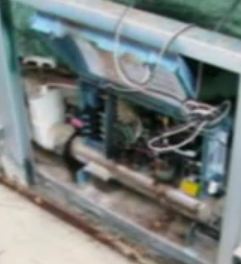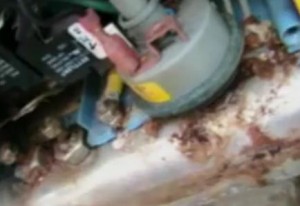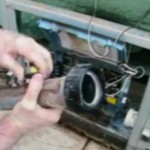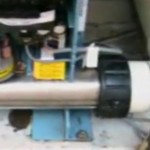 Hot Tub Heater Troubleshooting
Hot Tub Heater Troubleshooting
Hot tub heater troubleshooting may often lead to hot tub heater replacement. If the heater is more than a few years old, replacement may end up being the better choice.
Many flow-through type heaters with the heater element visible in the heater tube or manifold, can suffer from calcification – calcium deposits on the actual heater elemtn. If hot tub water is not maintained, calcium deposits can collect on the heater element over time.
This means the older the element is, the greater the chances of calcium and other buildup. This can lead to the heater working harder and harder to maintain the water temperature, and lead to high electricity bills.
The best prevention is to keep the pH in the water between 7.2-7.6 and treat any calcium rich water with the appropriate chemical product. Allowing the pH to wander in the higher range can lead to calcium precipitation and deposits which will clog up filter pores, possibly damage pump seals and the heater element as well.
 It is important to make sure the heater is at fault before replacing it. This is usually done by isolating the heater as the cause.
It is important to make sure the heater is at fault before replacing it. This is usually done by isolating the heater as the cause.
Heaters may short circuit, so the spa may operate normally until the heater kicks in and then all of a sudden trip the electrical breaker.
Hot Tub Heater Repair and Replacement
Read more about replacing hot tub heaters. If not qualified to work on electrical appliances/hot tubs, it is best to leave the repair to a local hot tub service technician. In any case, shut the power off completely at the panel and at the GFCI/disconnect to assure no power is going to the spa before working on electrical components. Resistance heaters or flow through heaters pass current across the heater element which is floated inside the heater manifold or tube (not touching any of the sides of the manifold).
Newer Balboa heaters include sensors within the heater manifold instead of external to the heater.
When ordering a replacement heater, it is important to note if the heater has sensors built into it (new style) or if it just has tabs on the outside for hooking up the sensor wires to. Some heaters may also have a pressure switch mounted directly to the heater manifold (usually on the backside of the heater), so this also needs to be specified when ordering a replacement heater.
Finally, the kilowatt rating should remain the same when replacing the heater, or an electrician should determine whether a different kw heater can be accommodated on the current electrical supply line(s).
Read about how hot hot tub temperatures are supposed to get.
 Heater problems may include low heat, no heat, overheating or short circuit which can cause the power breaker to trip. Another cause of a short circuit is a leak in the heater sheath or seal caused by poor water chemistry, corrosion or rusting or other reaason.
Heater problems may include low heat, no heat, overheating or short circuit which can cause the power breaker to trip. Another cause of a short circuit is a leak in the heater sheath or seal caused by poor water chemistry, corrosion or rusting or other reaason.
If there is a hole in the heater sheath or if it is shorting out, it is most advisable to replace the entire heater assembly.
Testing the Heater
With power off to the spa, measure the main power leads with a voltmeter to be sure there is no power going to the spa or no residual power that can cause a shock. Next, disconnect the main power leads from the heater terminals on the spa pack and measure the resistance with an ohm meter. Spa technicians will measure resistance in the 8-20 ohm range.
If there is no resistance, then a short circuit is present and if there is very high resistance there is no continuity at all.
Another test is to determine if the heater sheath shorts out to one of the heater posts or terminals. There should be the highest level of resistance (no continuity) from post to sheath, or else a short or partial short is suspected.
 Heater elements can be replaced if the heater chamber itself is in good shape and not that old. In that case, source a similar heater element with the same kw rating (pay attention to style – bowtie etc…. so that the replacement element fits in the place of the existing element without touching any of the sides inside the heater manifold (which can lead to a short).
Heater elements can be replaced if the heater chamber itself is in good shape and not that old. In that case, source a similar heater element with the same kw rating (pay attention to style – bowtie etc…. so that the replacement element fits in the place of the existing element without touching any of the sides inside the heater manifold (which can lead to a short).
Heater Troubleshooting
Sometimes the heater will not come on through no fault of the heater. An air lock may be present and the pressure switch or pressure sensor within the heater does not allow the heater to come on for safety reasons, or else a dry condition in the heater chamber could cause a dangerous overheating and damage spa components.
All spas are required to have some type of overheat protection as a safety device which can disable a perfectly functioning heater because of a water flow or other issue. So it is important to remove other sources of problems before ordering a new heater.
 Heater Trouble Prevention
Heater Trouble Prevention
Maintaining the pH level and the water chemistry can mean longer heater element life and also protect seals from corroding or damage to the heater sheath from occurring.
Multiple Heater Replacements
If water chemistry is maintained and heaters are failing often on the same spa, then a suspect could be an electronic component that may cause spikes to the heater such as a faulty thermostat, relay or contactor.
For replacement hot tub heaters in the U.S., visit Hot Tub Outpost.
For heaters in the United Kingdom, click here for replacement Pool Heater in the U.K.